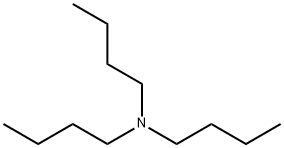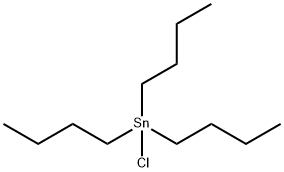S6049049
Tributylamine , ≥98.5% , 102-82-9
CAS NO.:102-82-9
Empirical Formula: C12H27N
Molecular Weight: 185.35
MDL number: MFCD00009431
EINECS: 203-058-7
Update time: 2022-07-08
PRODUCT Properties
| Melting point: | −70 °C(lit.) |
| Boiling point: | 216 °C(lit.) |
| Density | 0.778 g/mL at 25 °C(lit.) |
| vapor density | 6.38 (vs air) |
| vapor pressure | 0.3 mm Hg ( 20 °C) |
| refractive index | n |
| Flash point: | 146 °F |
| storage temp. | Store at RT. |
| solubility | sparingly soluble in water; soluble in most organic solvents; soluble
in acetone and benzene; very soluble in alcohol and ether |
| pka | 9.99±0.50(Predicted) |
| form | Liquid |
| color | Clear |
| PH | 10.6 (20°C in H2O, saturated aqueous solution) |
| explosive limit | 6% |
| Water Solubility | 0.386 g/L (25 ºC) |
| Sensitive | Hygroscopic |
| Merck | 14,9618 |
| BRN | 1698872 |
| Dielectric constant | 2.29 |
| Stability: | Stable. Combustible. Incompatible with strong oxidizing agents, strong acids. Hygroscopic. |
| LogP | 3.34 at 25℃ |
| CAS DataBase Reference | 102-82-9(CAS DataBase Reference) |
| NIST Chemistry Reference | Tributylamine(102-82-9) |
| EPA Substance Registry System | Tributylamine (102-82-9) |
Description and Uses
Tri-n-butylamine is an important intermediate in the production of phase transfer catalysts like tributylmethylammonium chloride and tributylbenzylammonium chloride. It is also used in pharmaceuticals, agrochemicals, surfactants, lubricant additives, vulcanization accelerators and dyes. It acts as a catalyst and as a solvent in organic syntheses and polymerization reactions. It serves as a strong base anion exchanger, acid acceptor, inhibitor in hydraulic fluids and an emulsifying agent. Further, it is used to prepare photographic chemicals.
Safety
| Symbol(GHS) |   GHS06,GHS08 |
| Signal word | Danger |
| Hazard statements | H302-H310+H330-H315-H372 |
| Precautionary statements | P262-P280-P301+P312-P302+P352+P310-P304+P340+P310-P314 |
| Hazard Codes | T,N,T+ |
| Risk Statements | 22-23/24-38-51/53-23/24/25-26-24 |
| Safety Statements | 26-36/37-45-61-36/37/39-28A-28 |
| RIDADR | UN 2542 6.1/PG 2 |
| WGK Germany | 2 |
| RTECS | YA0350000 |
| F | 10 |
| Autoignition Temperature | 410°F |
| TSCA | Yes |
| HazardClass | 6.1 |
| PackingGroup | II |
| HS Code | 29211980 |
| Hazardous Substances Data | 102-82-9(Hazardous Substances Data) |




